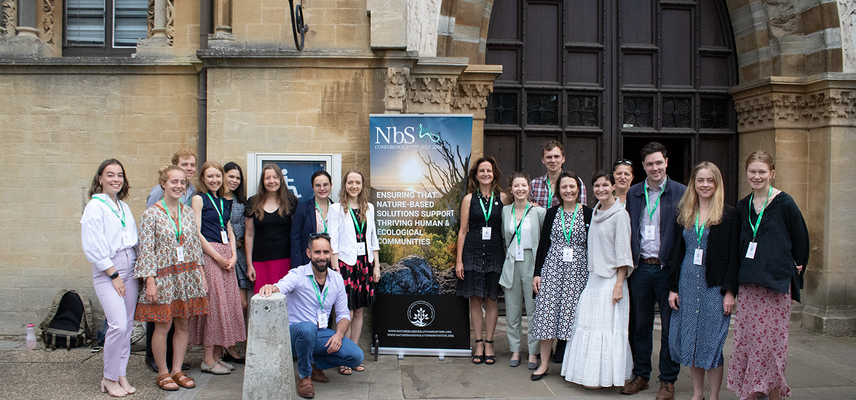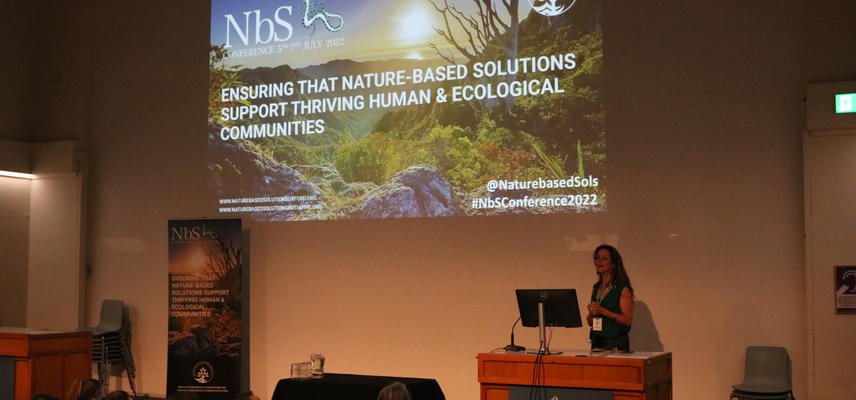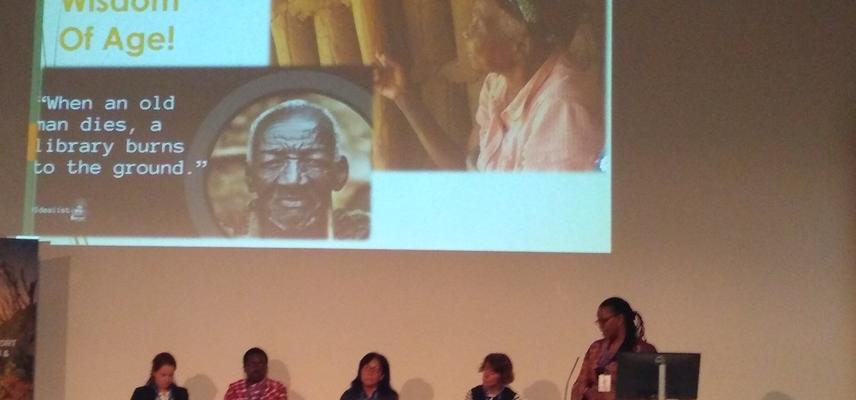Nature-based Solutions Conference 2022: key themes and outlooks
Experts gathered in Oxford this month to discuss how “nature-based solutions” can be used to tackle the twin threats of climate change and biodiversity loss.
Prof Nat Seddon delivers the opening address
Stewart Maginnis
Marina Melanidis with her talk on competing narratives around NbS
Musonda Mumba speaking on the importance of Indigenous peoples' knowledge
Over three days at the Oxford University Museum of Natural History, the Nature-based Solutions Conference considered techniques such as forest creation or mangrove restoration, which are increasingly appearing in climate strategies.
In theory, such projects could also help to reverse the loss of wildlife, provide economic boosts to local communities and strengthen resilience against climate impacts.
But the topic can be highly contentious and the conference provided a space for critics to outline their objections to nature-based solutions. Speakers took aim at companies and governments “greenwashing” and treating the natural world as a commodity.
In her opening address, conference organiser and founder of the Nature-based Solutions Initiative at the University of Oxford, Prof Nathalie Seddon, posed the central question of the event:
“How do we ensure that nature-based solutions support thriving human societies and ecosystems without compromising efforts to keep fossil fuels in the ground?”
Nat Seddon
What were some of the key themes that emerged from the scientists, Indigenous representatives, policy experts and activists who spoke there?
What are nature-based solutions?
When they began planning the conference two years ago, Seddon said her team had intended to explore the underlying evidence – the “why” of nature-based solutions.
In the intervening time, the topic had quickly evolved, she said, so instead the talks focused more on how to implement such solutions effectively.
Stewart Maginnis, global director of the Nature-based Solutions Group at the International Union for Conservation of Nature (IUCN) referred in his presentation to a resolution of the World Conservation Conference, which defines nature-based solutions as “actions to protect, sustainably manage, and restore natural or modified ecosystems, that address societal challenges effectively and adaptively, simultaneously providing human wellbeing and biodiversity benefits”.
As several attendees noted, they can also lessen the harmful effects of climate change on people and the environment by reducing the impact of disasters and fostering community resilience, as well as assisting in addressing biodiversity loss.
What are the biggest concerns around nature-based solutions?
While nature-based solutions could play a crucial role over the coming decades, the conference also highlighted challenges around their implementation and framing.
Marina Melanidis – founder and development director of Youth4Nature – explained the conflicting narratives around nature-based solutions in the first morning of the conference. The dominant narrative – held by governments and large organisations – is to view nature-based solutions as a “useful tool” for leveraging nature to suit our needs, she said. However, she added that among Indigenous communities and non-governmental organisations, they are often seen as a “dangerous distraction” from the need to cut emissions from fossil fuel use, which can perpetuate the existing “unjust status quo”.
In a separate session, Diego Pacheco – head of the Bolivian delegation to the UNFCCC – warned against the “commodification” of nature. He told attendees that the 21st century has seen a shift towards a market-centred “green economy”, which is based on a western paradigm and exploits nature for human gain. Instead, Pacheco proposed a “Mother Earth” approach, which strengthens the links between people and nature and is based on the views of Indigenous people.
How can nature-based solutions be scaled up effectively and fairly?
Much of the conference’s focus was on how nature-based solutions could be governed and expanded effectively.any of the speakers made it clear that this would require engagement with those living in targeted areas.
One session that focused on “fostering inclusive and restorative land use governance” began with a talk by Dr Constance McDermott from Oxford’s Environmental Change Institute, who discussed the various ambitious, global targets for the sector – a recent example being the zero deforestation pledge made at COP26.
McDermott drew on years of field work, explaining how local circumstances and numerous interacting – and sometimes conflicting – factors can compromise these kinds of international goals. She said:
“Those targets, if they don’t more seriously take into account issues of equity than they have so far, are more than likely to miss their mark.”
Who should pay for nature-based solutions?
One of the most popular questions from the audience was about who should pay for the implementation of nature-based solutions.
According to Vanessa Perez-Cirera, chief economist at the World Resources Institute, an additional $824bn per year of investment into nature is needed. She referred to this as the “nature funding gap”. She noted that considering carbon markets or offsetting as tools that could fill this gap, is “a misconception”.
Meanwhile, Helen Magata, communications officer of an Indigenous peoples’ organisation Tebtebba, mentioned that nature-based solutions are part of “daily rhythm” for Indigenous people. However, reports suggest that less than 1% of climate finance actually reaches them.
Speakers were broadly united by the idea that nature-based solutions should be financed by joint efforts of public, private, international and domestic sources.
However, when summarising the key conclusions from the financing session at the end of the second day, the organisers stated that “overarching constraints in unlocking private finance remain due to lack of capacity to ensure social safeguards materialise on the ground as well as lack of investor risk appetite”.
What is the role of Indigenous and local communities?
In her opening address, Seddon said the growing recognition of the “deep interdependency” between societal wellbeing and ecosystems shows that “western science has finally caught up with that which Indigenous people have known for a long time”. This was a running theme throughout the three-day conference.
In a session dedicated to the crucial role of Indigenous and local people, Musonda Kapena, director at Namfumu Conservation Trust in Zambia, told attendees that she is known as “mother of caterpillars” in her local community.
Women and children in her community harvest caterpillars – which are a delicacy in the region – she explained. As caterpillars become increasingly popular abroad, she explained that respecting local knowledge is crucial to managing the caterpillar harvest sustainably.
The session also featured Dismas Partalala Meitaya, from Tanzania’s Ujamaa Community Resource Team. He explained the importance of Indigenous land conservation and community land ownership, using a case study of the Hadzabe community, which is one of the last hunter gatherer groups in the world.
Meitaya and his team helped the community to secure more than 100,500 hectares of land and natural resources. This has improved both livelihoods for the community and biodiversity in the area. “Without land rights, everything else fails”, he told the conference.
However, issues with promoting nature-based solutions in Indigenous communities were also raised in this session.
Marisol García – a Kichwa youth leader from Peru – told the conference that the current model of nature-based solutions violates Indigenous rights. She added:
“We don’t think that nature-based solutions are anything new. Rather, this is a model of life that our ancestors have been promoting over hundreds of years. And now unfortunately, these are seen as a way to legalise pollution and generate wealth in our forests for a few very privileged people.”
Conclusions & takeaways
Finally, Prof Nathalie Seddon wrapped-up the conference, drawing out overall themes that had emerged from the conference. She noted the incredible enthusiasm for NbS evident across a range of sectors, and how it is already clear that deploying NbS could help address a number of critical challenges.
Moving forward, priorities for the NbS include continuing to build the scientific evidence base and identify best practices, particularly in how to build collaborate approaches reflecting the knowledge and worldviews of Indigenous peoples and local communities.
All that was left was to thank those who had made the conference such a success: the organisers, the tech support, and the Natural History Museum and Oxford Martin School teams who hosted the in-person sessions. And of course the speakers, for providing an excellent range of talks and discussions, and the delegates for proving such an insightful and engaged audience.






